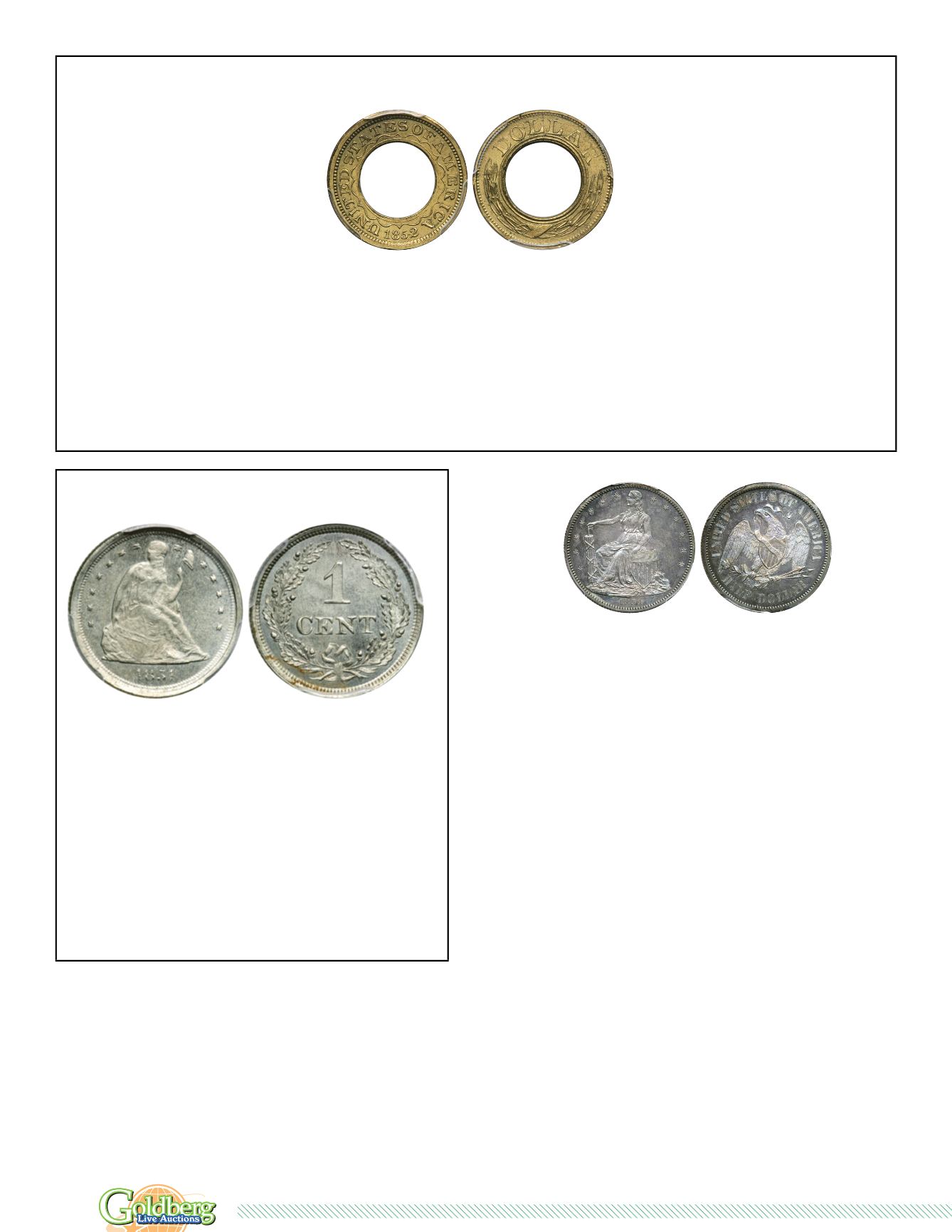
228
|
Patterns
1852 P
ATTERN
G
OLD
D
OLLAR
. J
UDD
-148
B
R
ARITY
8
Enlargement
1623
1852 Pattern Gold Dollar. Brass, Plain Edge. Judd-148b Rarity 8
.
PCGS graded Proof 63 PQ.
CAC Approved
. Tied for the finest at
PCGS. A rare Pattern annular Dollar struck from cracked dies in brass. During this period the silver coins were disappearing from circulation
due to the fact that they contained more bullion than their face value. Hence there was a demand for gold coins of the dollar and half-dollar
denomination. Walter Breen found in the Archives a letter from the Director of the Mint, George N. Eckert, to Senator R. M. T. Hunter dated
January 27, 1852, which shows that the half-dollar and larger ring-gold dollar were the first pieces made.
Fortunately the stopgap Act of 1853 reduced the silver content of the coins, making them worth less than face as bullion. This increased the
circulation of silver coins and relieved the need for the small gold pieces. Although the Act improved things, it caused greater problems down
the line.
Pop 2; none finer at PCGS
. (
PCGS # 11618
)
Estimated Value ........................................................................................................................................................... $15,000 - 16,000
1854 P
ATTERN
C
ENT
J
UDD
157
Enlargement
1624
1854 Pattern Cent. German Silver, Reeded Edge.
Judd-157. Pollock-185 High Rarity 7
.
PCGS graded
Proof 64.
CAC Approved
. Experimental. A scarce pat-
tern, the obverse is derived from a Seated dollar obverse
die, but crudely reduced by a circular lathe to the diameter
of a contemporary half cent. The 4 in the date resembles a
1 because of the blurry reduction. On the reverse, 1 CENT
is encircled by an oak and acorn wreath. Struck with a
reeded edge in a German silver alloy with the combination
stated above.
Pop 2; 2 finer, 1 in 64+, 1 in 65
. (
PCGS
# 11650
)
Estimated Value ........................................ $5,000 - 5,500
Ex: Samuel Berngard Collection
.
1625
1859 Pattern Half Dollar. Silver, Reeded Edge. Judd-
235. Pollock-282 Rarity 5
.
PCGS graded Proof 65.
CAC
Approved
. Nice blue toning and a bold Gem Proof. Anthony C.
Paquet's obverse design features a left-facing Liberty, seated,
supporting a fasces with her right hand and a shield with her
left. Thirteen small stars surround the periphery with the date,
1859, in exergue. Arrows and olive branches lie at the base of
the shield. Reverse Also by Paquet. A slightly disproportionate
eagle, with wings spread, holds three slender arrows in its left
claw and an olive sprig with its right talon. The perfect scroll
held in the eagle's beak reads E PLURIBUS UNUM with UNITED
STATES OF AMERICA occupying the upper periphery and HALF
DOLLAR the lower. The vertical lines in the shield are in groups
of four each, as opposed to three lines as found on the similar
"broken ribbon" version of this pattern. Struck in silver with a
reeded edge. A sharply impressed and wonderfully preserved
example.
Pop 5; none finer at PCGS
. (
PCGS # 11960
)
Note: Anthony C. Paquet designed several Pattern pieces in the
mid-nineteenth century, including a variation on the 1858 Gold
Dollar. He was noted for his tall ornate lettering, which is easily
spotted by those familiar with it. His most famous design, one
which actually made it into limited production, was the 1861
Liberty Head Double Eagle with Paquet reverse. The Paquet-
designed San Francisco mint version is available periodically.
Estimated Value ..............................................$4,500 - 5,000


